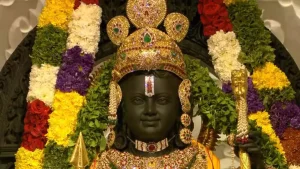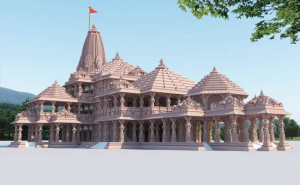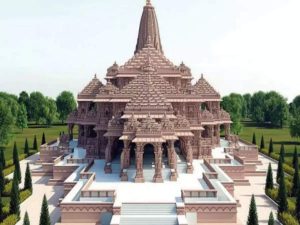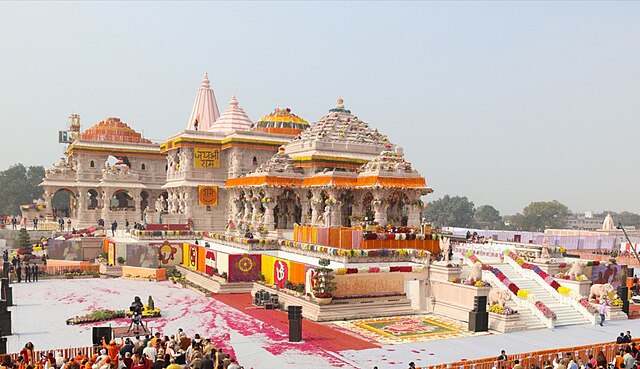Lord Shri Ram Temple, also known as the Ayodhya Ram Mandir, is a Hindu temple that can be seen in Ayodhya, which is situated in the state of Uttar Pradesh in India. In India, the ayodhya temple has been at the epicenter of a religious and political controversy that has been going on for a very long time. The ram mandir construction of the new Hindu sri rama temple at Ram Janm Bhumi is now underway, and Hindus all around the globe are looking forward to its inauguration. Everything you need to know about the inauguration of the shri ram mandir ayodhya in 2024 is right here. On the 22nd of January, 2024, it is scheduled to open, and Prime Minister Shri Narendra Modi would be the one to inaugurate it. The city of Ayodhya, which is the location of the hare ram hare krishna mandir, is revered as a holy site since it is the spot where Lord Shri Ram was born. On the 22nd of January in the year 2024, the largest hindu temple in the world is anticipated to be finished.
Following the announcement of the ram mandir opening date, they will begin enabling individuals to make reservations for tickets to attend the event. It is necessary for you to register for the shri ram mandir ayodhya visit in 2024 in order to do this. If you wish to see the new Ram Mandir after it is done being constructed, you are need to register for this event.
This page will provide further information on the history, architecture, and importance of the Ayodhya Ram Mandir, as well as instructions on how to get there.

The Ram Mandir in Ayodhya: A Brief History
The Ayodhya Mandir has a history that dates back over many centuries. The temple is constructed on the spot that is said to be the birthplace of Lord Ram, who is considered to be one of the most revered deities in Hinduism. In the sixteenth century, the Mughal emperor Babur was responsible for the destruction of the sri rama temple, for which a mosque was constructed in its stead. For decades, the mosque, which was known as the Babri Masjid, existed on the site. In 1992, Hindu nationalists razed the mosque, which resulted in severe bloodshed and communal tensions across the country.
For many decades, the Ayodhya temple controversy has been a difficult subject in the political situation of India. The disagreement concern the ownership of the land on which the Babri Masjid was located, as well as the question of whether or not it was the area where Lord Ram was born. The disagreement was ultimately resolved by the Supreme Court of India in 2019, which issued a ruling that favored the building of a Ram Janmabhoomi temple on the site. In order to supervise the building of the temple, the Shri Ram Janmabhoomi Teerth Kshetra, which was established by the Indian government, was the organization that was responsible for carrying out the ram mandir construction of the temple.
The Ayodhya Ram Mandir’s Architecture and Characteristics of the Building
Towering spires, also known as shikharas, are a distinguishing feature of the Ayodhya Ram Mandir, which is a magnificent temple that was constructed in the Nagara style of temple building. Pink sandstone was used in the ram mandir construction of the temple, which sprawls over an area that is 2.77 acres in size. Additionally, the sri rama temple is encircled by a large courtyard and has a number of smaller shrines that are devoted to several different Hindu deities. The enormous Shaligram stone, which is a black stone that is supposed to symbolize Lord Ram and was taken from the Gandaki river in Nepal, is the architectural element that stands out the most about the largest hindu temple in the world.
There are three storeys in the hare ram hare krishna mandir, each of which has a particular function. The temple is 161 feet tall. There is a museum on the third level that displays the history and culture of Ayodhya. The first floor is devoted to Lord Ram, the second floor is devoted to Lord Hanuman, and the third floor is a museum.
Additionally, the compound of the sri rama temple has a yajnashala, which is a hall for the purpose of performing yajnas, which are Hindu fire rites, as well as a communal kitchen and a medical center. The temple complex encompasses 67 acres and is anticipated to develop into a significant cultural and religious hub that will draw millions of devotees from all over the globe during the course of its existence.

Ayodhya Ram Mandir has a significant place in the hearts of Hindus.
The Ayodhya Ram Mandir is widely regarded as one of the most significant pilgrimage destinations for Hindus at the present time. For this reason, it is revered as a holy spot since it is said to be the place where Lord Ram was born. It is widely acknowledged that the completion of the temple represents a significant success for the Hindu community, who had been struggling for the construction of the temple for many decades.
It is anticipated that the temple would play a significant role in the development of shri ram mandir ayodhya as a major hub of religious and cultural activity. The creation of employment and the acceleration of economic development in the area are other anticipated outcomes of this. It is anticipated that the temple would draw millions of devotees from all across India and the globe, which will contribute to the growth of Ayodhya as a significant hub for religious and cultural activities.
How to Get to the State of Ayodhya The Ram Temple
Maryada Purushottam Shri Ram International Airport, more often referred to as Ayodhya mandir International Airport, is a future international airport that being built with the intention of providing service to the cities of Faizabad and Ayodhya, which are located in the state of Uttar Pradesh in India. Around 8.5 kilometers separate this airport from Faizabad. The name of the airport was changed in 2021 to commemorate Lord Shri Rama. It is located in the Ayodhya district, close to the intersection of National Highway 27 and National Highway 330 near Naka. On December 30, 2023, Prime Minister Narendra Modi is slated to participate in the ceremony that will officially open the airport. Beginning on January 10, 2024, it is anticipated that flight operations will begin off. There is also the possibility of using the Charan Singh International Airport in Lucknow, which is located roughly 135 kilometers away from Ayodhya. From this airport, one may rent a cab or take a bus to go to Ayodhya.
Additionally, Ayodhya mandir is well-connected by both road and rail. The Ayodhya Junction railway station is an important railway hub that serves the area. It is located in the city of Ayodhya, which is located in the state of Uttar Pradesh in India. Within Ayodhya, it is one of the two important railway junctions, the other being Faizabad Junction, which is well-connected to major towns in India. Faizabad Junction is the second significant railway junction. It is possible to go to Ayodhya by rail from large cities like as Delhi, Mumbai, Kolkata, or any other big city. To get to the sri rama temple, you may either take a local bus or rent a cab from the station where the train arrives.
Road connections also exist between Ayodhya and the main cities in the state of Uttar Pradesh. To go to Ayodhya from Lucknow, Varanasi, or any of the other main cities in India, you may either take a bus or rent a cab.

Final Thoughts
The Ayodhya Ram Mandir is more than simply a place of worship; it is also a representation of our shared cultural history, togetherness, and religion. In the annals of Indian history, the achievement of truth, justice, and righteousness is symbolized by the building of the temple, which is a historically significant event. The temple is a testament to the unyielding devotion of the Hindu community to Lord Ram and provides evidence of the continuing spirit of the Hindu community.
In India, the Ayodhya Ram Mandir has been at the epicenter of a religious and political controversy that has been going on for a very long time. However, the controversy has been resolved, and the site has been returned to the people who were legally entitled to own it. This was accomplished via the building of the Ram Janmabhoomi temple. In addition to serving as a source of inspiration and hope, the temple serves as a constant reminder of the power of faith and the resilience of the human spirit.
At the same time when India is getting ready to inaugurate the shri ram mandir ayodhya temple, the temple promises to be a location where people may experience a spiritual and cultural awakening. It serves as a monument to the extensive cultural and religious history of India, as well as a memorial to the lasting legacy that Lord Sri rama temple has left behind.

